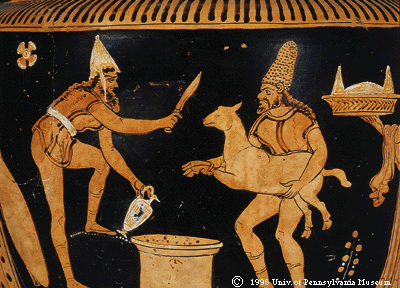Religion and
Death
Votives and
Sacrifice

Votives were gifts offered to the gods by their
worshippers. They were often given in thanks for something good
happening or to ask the gods for a favour. Sometimes they could be
offered as an apology to the gods for crimes involving blood-guilt,
or the breaking religious customs. They could be given either
voluntarily or in response to demands by the cult's
priesthood.
 Votives were kept on display in the god's sanctuary for a set period
of time and then were usually ritually discarded. Bronze tripods,
prize cauldrons and figurines, terracotta tablets and figurines,
lamps, and vases are typical examples. Armour, weapons, jewelry and
other more personalized items were dedicated in large numbers, along
with marble statuettes and reliefs.
Votives were kept on display in the god's sanctuary for a set period
of time and then were usually ritually discarded. Bronze tripods,
prize cauldrons and figurines, terracotta tablets and figurines,
lamps, and vases are typical examples. Armour, weapons, jewelry and
other more personalized items were dedicated in large numbers, along
with marble statuettes and reliefs.
Some of the healing sanctuaries housed copies of
body parts donated in thanks for or in hope of cures. Large
sculptural monuments in bronze, marble and other costly materials
were routinely donated by either private donors or individual
city-states in the great Panhellenic sanctuaries like Olympia and
Delphi.
Sacrifices were also thought of as gifts to the
gods. They took the form of bloodless offerings such as grasses,
roots, cereal grains, fruits, cheese, oil, honey, milk and incense,
or were blood-offerings like wild and domesticated animals, birds and
fish. The foodstuffs and liquids were either burnt on raised altars
so that their smell could rise heavenward or dropped or poured into
wells, holes or tombs. What was left was usually eaten by the
sacrificers.
 Attic Red Figure Kylix
Attic Red Figure Kylix
ca. 480 BC
By the Foundry Painter and the potter Euphronios
31-19-2
A centauromachy or battle between two armed Greek warriors
and an elderly centaur armed with the limb of a tree.
H. 9.7; L. 31.2; Dia. 23.8 cm. Photo by Maria Daniels for the
Perseus Project. (large
version)
 South Italian Greek Terracotta Votive Figurine
South Italian Greek Terracotta Votive Figurine
ca. 450-425 BC
MS 1857
Either a Demeter or Persephone figurine or a priestess. The low
polos headdress is associated with both, but the apron
suggests a priestess. Carrying a piglet, she holds aloft a circular
box or kanoun. Inexpensive terracottas depicting female
subjects turn up in very large quantities in sanctuaries dedicated to
female goddesses throughout the Greek world. Women were especially
active in all aspects of Demeter's cult.
H. 32.5; W. 13.0; Th. 8.0 cm. UM neg. S8-55808. (large
verison)
 Attic Red Figure Kylix
Attic Red Figure Kylix
ca. 490-480 BC
By the Antiphon Painter and the potter Euphronios
Perhaps Chiusi, Italy
MS 2448
A youth walks along with a piglet and a sacrificial basket. The
piglet was the favorite animal to sacrifice to Demeter and her
daughter, Persephone, but could also be offered to other deities. In
the autumn Demeter's Eleusinian initiates walked to the Saronic Gulf,
each carrying a piglet. The animals were purified in the sea before
being sacrificed. It may be a moment from this familiar annual event
that is pictured here.
H. 10.0; L. 31.0; Dia. 24.0 cm. Photo by Maria Daniels for the
Perseus Project. (large
version)
 Apulian Red Figure Krater
Apulian Red Figure Krater
4th century BC
On loan, Philadelphia Museum of Art
L-64-42 detail
Scene of sacrifice, perhaps from a play. A grotesque bearded man,
perhaps a slave, wearing a short chiton, high sandals and pointed
straw hat, stands in front of an altar. He holds a libation pitcher
and large knife. A second comic or bearded, mustachioed male, wearing
a tall felt hat and short chiton, holds a sheep over an altar. A
woman holds out a ritual winnowing basket, used in the rites of
Demeter and Dionysus.
Photo courtesy Mediterranean Section, Univ. of Pennsylvania
Museum. (large
version)





The Ancient Greek World Index


![]() Votives were kept on display in the god's sanctuary for a set period
of time and then were usually ritually discarded. Bronze tripods,
prize cauldrons and figurines, terracotta tablets and figurines,
lamps, and vases are typical examples. Armour, weapons, jewelry and
other more personalized items were dedicated in large numbers, along
with marble statuettes and reliefs.
Votives were kept on display in the god's sanctuary for a set period
of time and then were usually ritually discarded. Bronze tripods,
prize cauldrons and figurines, terracotta tablets and figurines,
lamps, and vases are typical examples. Armour, weapons, jewelry and
other more personalized items were dedicated in large numbers, along
with marble statuettes and reliefs.  Attic Red Figure Kylix
Attic Red Figure Kylix South Italian Greek Terracotta Votive Figurine
South Italian Greek Terracotta Votive Figurine Attic Red Figure Kylix
Attic Red Figure Kylix Apulian Red Figure Krater
Apulian Red Figure Krater